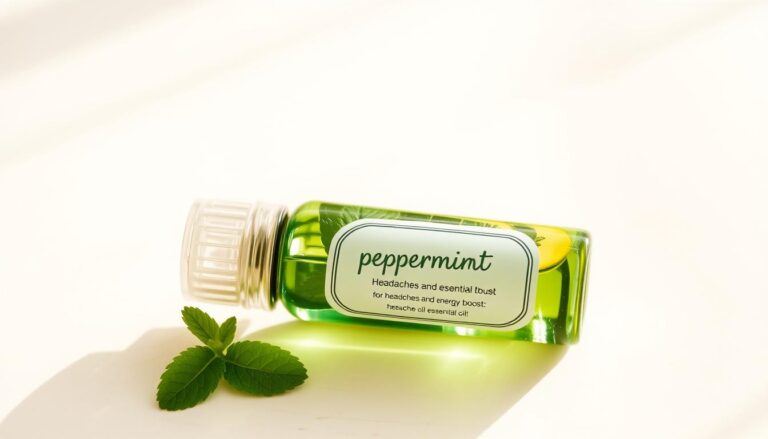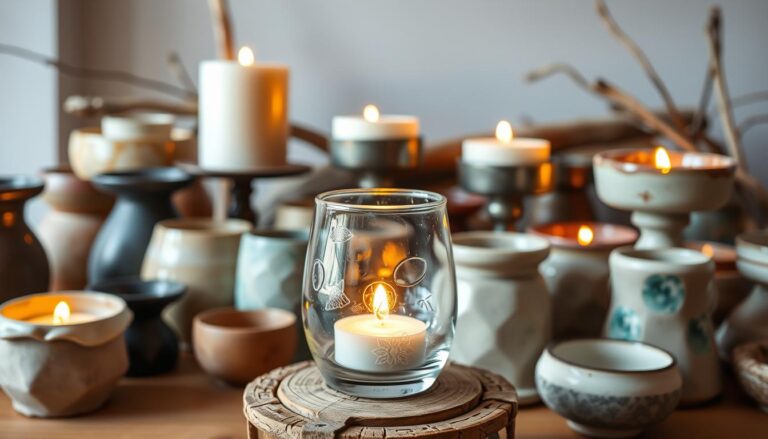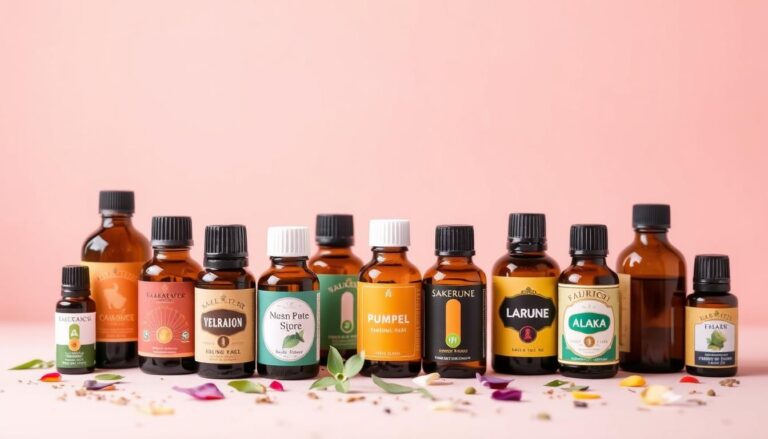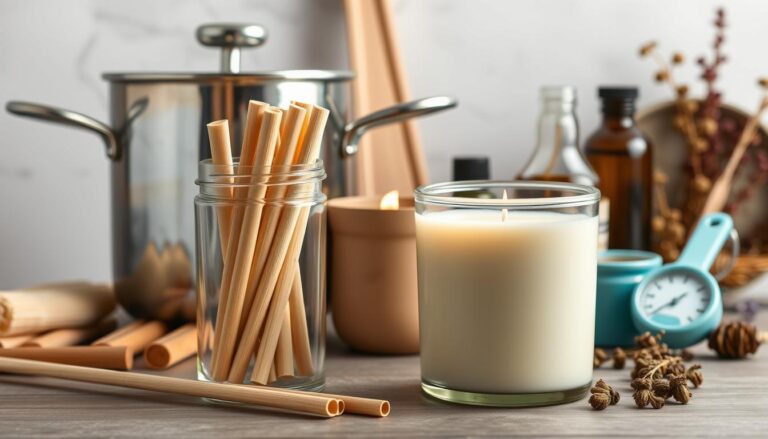Are you just getting started in candle-making? Then read about the 11 must-have essential oils to bring your homemade candles to a whole new level.
Welcome to the vibrant world of candle crafting!
If you’re just starting out, you’ll quickly discover how plant extracts can elevate your creations.
These concentrated botanical wonders aren’t just about fragrance, they turn simple wax into mood-boosting experiences.
Imagine your home filled with calming lavender or energizing citrus notes, all from your own hands.
Did you know it takes 250 pounds of lavender flowers to produce just one pound of lavender extract?
That’s why these potent formulas pack such aromatic power.
When blended into candles, they release lasting scents that commercial products often can’t match.
You’re not just making decorations, you’re crafting personal wellness tools.
This guide simplifies your journey into botanical candle crafting.
In the next minutes, we’ll explore versatile extracts perfect for beginners, from cozy vanilla to refreshing peppermint.
You’ll learn blending techniques, safety tips, and how to balance scents like a pro. Let’s create candles that tell your story through every flickering flame.
Key Takeaways
- Plant extracts transform candles into therapeutic tools for mood enhancement
- High concentration levels ensure long-lasting fragrance in homemade creations
- Beginner-friendly options simplify scent blending for custom aromas
- Proper usage techniques maximize safety and scent performance
- Versatile botanical choices adapt to seasonal or personal preferences
Curating Your Kit: Must Have Essential Oils
Here are 11 must-have essential oils for candle makers.
Each oil is selected for its scent strength, versatility, and ability to anchor or enhance blends in soy, beeswax, or coconut wax candles.
1. Cedarwood Atlas
- Note: Base
- Scent: Warm, woody, grounding
- Best for: Masculine, earthy, winter blends
- Blends well with: Bergamot, Orange, Patchouli
2. Sweet Orange
- Note: Top
- Scent: Bright, sweet, clean
- Best for: Kitchen, holiday, or spa candles
- Blends well with: Cinnamon, Clove, Vanilla
3. Patchouli
- Note: Base
- Scent: Earthy, musky, grounding
- Best for: Autumn, romantic, or mystic candles
- Blends well with: Lavender, Orange, Frankincense
4. Vanilla Oleoresin
- Note: Base
- Scent: Sweet, creamy, cozy
- Best for: Dessert, winter, or relaxing candles
- Blends well with: Coffee, Orange, Cinnamon
5. Lavender
- Note: Middle
- Scent: Herbal, floral, clean
- Best for: Spa, bedroom, or calming candles
- Blends well with: Lemon, Patchouli, Cedarwood
6. Lemongrass
- Note: Top
- Scent: Sharp, lemony, green
- Best for: Fresh, clean, energizing candles
- Blends well with: Eucalyptus, Rosemary, Tea Tree
7. Ylang Ylang
- Note: Middle/Base
- Scent: Floral, exotic, sweet
- Best for: Romantic, spring, or tropical blends
- Blends well with: Orange, Patchouli, Vanilla
8. Cinnamon Bark
- Note: Middle
- Scent: Spicy, warm, holiday
- Best for: Fall, holiday, dessert blends
- Blends well with: Orange, Clove, Vanilla
9. Eucalyptus Radiata
- Note: Top
- Scent: Clean, minty, sharp
- Best for: Wellness or fresh air candles
- Blends well with: Peppermint, Lemongrass, Tea Tree
10. Rosemary
- Note: Middle
- Scent: Herbal, sharp, pine-like
- Best for: Focus, kitchen, or garden candles
- Blends well with: Lavender, Lemon, Cedarwood
11. Frankincense
- Note: Base
- Scent: Resinous, deep, meditative
- Best for: Spiritual, grounding, or winter candles
- Blends well with: Myrrh, Orange, Patchouli
Candle Mixing Instructions (for 8 oz soy candle)
🕯️ Target scent load:
- 6–10% of wax weight in essential oils.
- For 8 oz (226g) soy wax → use 14–22g (or ~280–440 drops) of Essential Oil blend.
Proportional Blend Guidelines:
Use this ratio for balanced scent layering:
- Top Notes: 30%
- Middle Notes: 50%
- Base Notes: 20%
Example Blend: Warm Comfort Candle
For an 8 oz candle with 300 drops total:
- 90 drops Sweet Orange (Top)
- 150 drops Cinnamon Bark (Middle)
- 60 drops Vanilla oleoresin (Base)
Pro Tips for Candle Success:
- Mix essential oils into wax at 185°F (85°C), then pour at 135–145°F (57–63°C)
- Let candles cure for 5–7 days before lighting
- Use essential oil solubilizers or fixatives (like benzoin or resinous bases) to enhance scent throw
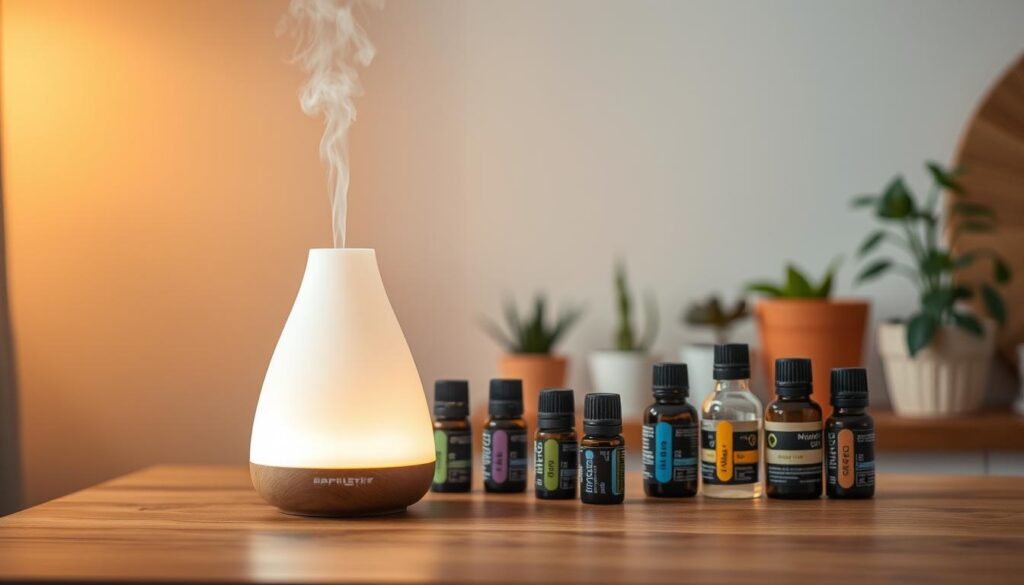
Introduction: Exploring the World of Essential Oils
Picture your candles becoming natural storytellers, releasing scents shaped by centuries of botanical wisdom.
These plant-based extracts do more than smell nice. They connect you to nature’s rhythms through every flicker.
Related topic: Best Essential Oil Blends for Scented Candles.
What Are Essential Oils?
Essential oils are botanical extracts that capture a plant’s character through careful extraction.
Steam distillation passes hot vapor through lavender or eucalyptus, trapping their essence in droplets.
Citrus peels release bright notes through cold pressing instead.
These methods preserve nature’s complexity. A single drop contains hundreds of compounds that synthetic fragrances can’t replicate.
Ancient Egyptians used them in rituals, while modern crafters blend them into candles for deeper connections.
Why They Matter in Candle Making
Natural scents transform wax into wellness tools.
Unlike artificial perfumes, botanical extracts interact with your senses authentically.
Their therapeutic properties can calm nerves or sharpen focus as the flame dances.
Choosing plant-based options means your creations support well-being. You’re not just melting wax, you’re designing experiences that honor nature’s intelligence.
Each candle becomes a bridge between tradition and modern self-care.
Benefits of Essential Oils in Candle Crafting
Transform your living space into a sanctuary that works smarter, not harder.
Plant-based scents in candles do double duty: they create inviting atmospheres while supporting your well-being naturally.
Enhancing Mood and Ambience
Your home’s aroma shapes daily experiences.
Bright citrus notes in home offices can sharpen focus during work hours, while lavender-infused candles help bedrooms transition into sleep-ready zones after dark.
Studies reveal scent influences emotions faster than other senses.
A rosemary candle might boost productivity, while vanilla creates cozy weekend vibes.
Rotate scents seasonally: fresh pine for winter gatherings, floral blends for spring renewal.
Health and Therapeutic Advantages
Beyond pleasant fragrances, certain plant extracts offer science-backed benefits.
Eucalyptus candles may help clear stuffy noses, while tea tree releases airborne cleansing properties as they burn.
Nighttime routines gain new depth with chamomile-infused creations. Research shows their gentle aroma can lower heart rates, preparing your body for deeper sleep.
For tension relief, try candles blended with frankincense as its earthy notes have calmed minds for centuries.
Incorporating Essential Oils into Your Candle Recipes
Mastering scent integration transforms candle making from craft to art. Whether you’re designing relaxation aids or seasonal centerpieces, your method determines both fragrance quality and therapeutic value.
Diffusion Versus Direct Application
Room diffusers mix botanical extracts with water, releasing subtle aromas through mist. For candles, you’ll add concentrated drops directly to melted wax.
Direct infusion creates stronger scent throws that activate when heated.
Use 30-40 drops per pound of wax for balanced diffusion. Start with fewer drops for citrus scents as they naturally project farther.
Always test new combinations in 4 oz candles first to prevent wasted materials.
Blending Techniques for Signature Scents
To make a signature fragrance, layer scents like perfume makers do.
Begin with base notes like cedarwood (15% of blend), add middle tones like lavender (35%), then finish with top accents like bergamot (50%).
This creates evolving aromas as candles burn.
- Morning energizer: 3 drops grapefruit + 2 drops peppermint
- Evening unwind: 4 drops chamomile + 1 drop vanilla
- Seasonal special: 2 drops cinnamon + 3 drops orange
Add botanical extracts when wax cools to 140°F, hot enough to bind, cool enough to preserve benefits.
Stir gently for 2 minutes to ensure even distribution. Your creations will smell professional while keeping nature’s wisdom intact.
Safety and Dilution Guidelines for Essential Oils
Creating safe, aromatic candles starts with understanding how to handle concentrated plant extracts.
Dr. Lin, a leading aromatherapy researcher, emphasizes that even small amounts can impact your body if mishandled.
Let’s explore how to protect your skin and craft responsibly.
Proper Dilution Methods
Always mix plant extracts with carrier oils before adding to wax.
For candle making, use 6-10 drops per ounce of wax. Sensitive groups like children or pregnant individuals need even lighter concentrations.
| Plant Extract | Carrier Oil Ratio | Max Drops/Oz Wax |
|---|---|---|
| Lavender | 1:4 | 8 |
| Tea Tree | 1:6 | 6 |
| Eucalyptus | 1:8 | 5 |
Usage Cautions and Best Practices
Wear gloves when handling undiluted formulas to prevent skin reactions.
Keep bottles clearly labeled and stored away from pets as some extracts become toxic if licked.
Tea tree and eucalyptus require extra care due to their potency.
Ventilate your workspace well during crafting. Those with allergies should test candles in small spaces first.
Remember, proper care ensures everyone enjoys your creations safely.

Creative Blends and Custom Aromatherapy Ideas
Unlock your inner perfumer by combining botanical extracts into signature candle creations. Thoughtful blending lets you craft scents that shift with the seasons or support daily rhythms.
Start with these tested combinations to spark your aromatic experiments.
Mixing for Memorable Moments
Pair lavender with bergamot and ylang ylang for stress-melting candles.
Research shows this trio lowers blood pressure while creating a floral oasis. Balance strong peppermint with sweet orange – 2 drops to 3 – for invigorating morning blends that won’t overwhelm.
Try rosemary and frankincense for study sessions.
Their earthy notes sharpen focus while promoting mental clarity.
Document ratios in a scent journal to recreate winning formulas later.
Scents That Follow the Calendar
| Season | Blend | Effect |
|---|---|---|
| Winter | Frankincense + Cedarwood | Grounding warmth |
| Spring | Lemon + Lavender | Fresh renewal |
| Summer | Eucalyptus + Spearmint | Cooling refreshment |
Design day-specific aromas using time-tested pairings. Energize mornings with peppermint and grapefruit. Wind down evenings with chamomile-vanilla candles that ease you toward sleep.
Rotate blends every 6-8 weeks to keep your space feeling inspired.
Practical Candle Making Techniques with Essential Oils
Turn your kitchen into a candle lab where science meets creativity.
Discover how temperature control and smart blending can turn simple wax into aromatic masterpieces.
Let’s explore methods that preserve plant benefits while maximizing fragrance.
Infusing Oils Directly into Wax
Different wax types need unique approaches.
Soy works best at 135°F, which is hot enough to bind oils without burning off delicate notes.
Beeswax requires slightly higher heat (145°F) for proper absorption.
| Wax Type | Mixing Temp | Drops per Pound | Burn Quality |
|---|---|---|---|
| Soy | 135°F | 35-40 | Clean, even |
| Beeswax | 145°F | 30-35 | Slow, steady |
| Paraffin | 160°F | 40-45 | Strong throw |
Create layered scents by pouring wax in stages. Add bergamot to the first layer, sandalwood to the second. As the candle burns, aromas evolve like chapters in a story.
DIY Approaches to Enhance Aromatherapy
Pair your candles with steam therapy for full sensory experiences. Add 3 drops of eucalyptus to boiling water, then drape a towel over your head.
Breathe deeply while your matching candle flickers nearby.
- Bath synergy: Float citrus-scented candles near tubs filled with 5 drops of bergamot oil
- Diffuser combo: Match peppermint candles with room misters using identical oil ratios
- Sleep routine: Light lavender candles 30 minutes before bedtime steam sessions
If candles lose scent quickly, try adding oils at lower temperatures. For uneven burns, trim wicks to ¼ inch before relighting. Your creations will perform like pros with these tweaks.
Essential Oils in Candle-Making
Your journey into botanical candle crafting is just beginning. The 11 plant extracts we’ve explored offer more than pleasant aromas, they bring physical benefits like:
- soothing inflammation,
- supporting skin health,
- uplifting mood.
Each flickering flame becomes a tool for wellness, merging ancient wisdom with modern creativity.
Start with these versatile options as your core collection.
Lavender’s calming effects and tea tree’s cleansing qualities provide endless possibilities for custom creations.
As you grow confident in blending techniques, expand your toolkit with complementary scents that reflect your personal style.
Don’t hesitate to mix citrus bursts with earthy undertones or floral notes with spicy accents.
Keep safety guidelines in mind as you experiment. Proper dilution ensures both potency and gentle use.
Every new combination you craft adds depth to your candle-making practice, turning simple projects into meaningful rituals.
FAQ
What are essential oils, and why use them in candles?
Essential oils are concentrated plant extracts that add natural fragrance to candles. Unlike synthetic scents, they offer therapeutic benefits like stress relief or improved focus, enhancing both ambience and wellness.
Which oils work best for beginners making candles?
Lavender, lemon, and eucalyptus are beginner-friendly. Lavender promotes relaxation, lemon adds freshness, and eucalyptus clears the air. These oils blend easily and retain their aroma when heated in wax.
How do I safely dilute oils for candle recipes?
Follow a 6-10% dilution rate: add 60-100 drops per pound of wax. Use a carrier oil like coconut or soy wax to bind the scent. Always test small batches to avoid overpowering fragrances or uneven burning.
Can I mix different oils to create unique scents?
Absolutely! Try combining peppermint with orange for a zesty blend or cedarwood with bergamot for earthy warmth. Start with 3-4 drops per oil, adjusting ratios until you achieve your signature aroma.
Are there oils to avoid in candle making?
Citrus oils like lime can degrade wax over time, while cinnamon bark may irritate sensitive skin. Research flash points and stability—oils like tea tree or rosemary often need lower temperatures to preserve their properties.
How do I make candles with stronger aromatherapy benefits?
Use oils known for their therapeutic qualities. For example, add frankincense for grounding or ylang-ylang for relaxation. Pour wax at cooler temps (around 135°F) to lock in volatile compounds that boost scent throw.
What’s the best way to store oils for candle crafting?
Keep them in dark glass bottles away from heat and sunlight. Refrigeration extends shelf life, especially for citrus or floral oils like rose or bergamot, which can oxidize faster.
